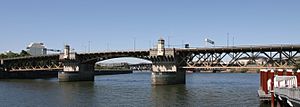Burnside Bridge facts for kids
Quick facts for kids Burnside Bridge |
|
|---|---|
 |
|
| Crosses | Willamette River |
| Locale | Portland, Oregon |
| Maintained by | Multnomah County |
| ID number | 02757 |
| Characteristics | |
| Design | Double-leaf "Strauss-type" bascule |
| Total length | 1,382 ft (421 m) |
| Width | 73.8 ft (22.5 m) |
| Longest span | Fixed: 268 ft (82 m) Double-leaf bascule: 252 ft (77 m) |
| Clearance below | 64 ft (20 m) closed |
| History | |
| Designer | Ira G. Hedrick; Robert E. Kremers |
| Opened | May 28, 1926 (replaced 1894 bridge) |
|
Burnside Bridge
|
|
| Location | Portland, Oregon; Willamette River at river mile 12.7 |
| MPS | Willamette River Highway Bridges of Portland, Oregon |
| NRHP reference No. | 12000931 |
| Added to NRHP | November 14, 2012 |
The Burnside Bridge is a special kind of bridge called a bascule bridge. It was built in 1926. This bridge crosses the Willamette River in Portland, Oregon, USA. It carries Burnside Street across the river. This is actually the second bridge with the same name in this spot. It became a historic place in 2012.
Contents
What is the Burnside Bridge?
The Burnside Bridge is a "bascule" bridge. This means it has a part that can lift up. This allows boats to pass underneath.
How Was the Bridge Designed?
Two engineers, Ira G. Hedrick and Robert E. Kremers, designed the Burnside Bridge. The special lifting part was designed by Joseph Strauss. He was famous for designing many bascule bridges.
The Burnside Bridge is very long. Including its ramps, it stretches about 2,308 ft (703 m). The middle part that lifts up is 251 ft (77 m) long. When the bridge is closed, there is 64 ft (20 m) of space below it for boats.
The top of the bridge is made of concrete. This makes it one of the heaviest bascule bridges in the United States. To help lift the heavy bridge, there are huge weights called counterweights. These weights are hidden inside the two towers. They weigh about 1,700 short tons (1,518 long tons; 1,542 t).
Usually, the person who operates the Hawthorne Bridge also controls the Burnside Bridge. But if the river water is very high, someone works from the west tower of the Burnside Bridge. In 2005, the bridge opened about 35 times each month for river traffic.
What's Under the Bridge?
The east end of the bridge provides shelter for the Burnside Skatepark. This skatepark was built without official permission at first. For many years, the Portland Saturday Market was held mostly under the west end of the bridge. The market moved a bit in 2009. But the Burnside Bridge still covers some of the market's stalls.
History of the Burnside Bridge
The street the bridge is on, Burnside Street, got its name in 1891. It was named after Dan Wyman Burnside. He was a local businessman who helped get the Willamette River deepened in 1866.
The First Bridge
The first Burnside Bridge started being built in November 1892. It opened on July 4, 1894. That bridge was a swing bridge. A swing bridge turns sideways to let boats pass. It was made of iron and steel.
Building the Current Bridge
The current Burnside Bridge was part of a big project. This project also included building the Ross Island Bridge and Sellwood Bridge. The total cost was $4.5 million. There was a problem with the contract for the new bridge. It was given for $500,000 more than the lowest offer.
Some local leaders had moved the bridge's location to make money by selling their land. Because of this, three Multnomah County officials were removed from their jobs. A new engineering company then took over the project.
The current Burnside Bridge opened on May 28, 1926. Its final cost was $4.5 million. This was the first bridge over the Willamette River in Portland that an architect helped design. This is why it has fancy Italian Renaissance towers and decorative metal railings. The lifting system was designed by Joseph Strauss. The first engineers were Hedrick & Kremers. Then, Gustav Lindenthal finished the bridge and watched over its construction.
Bridge Use Over Time
Streetcars used to cross the Burnside Bridge until 1950. Electric trolleybuses also used it from 1936 to 1958. Today, three TriMet bus routes still use the bridge.
In the 1990s, the Burnside Bridge became an important route for emergencies. It was the only non-freeway bridge for emergency vehicles. In 1995, one of its six lanes was removed. This made space for new bicycle lanes.
From March to November 2002, the bridge had a $2.1 million upgrade. This was to make it safer during earthquakes. It was the first bridge in Multnomah County to get this kind of earthquake protection.
The bridge was also worked on in 2006 to replace its deck. During this work, old streetcar tracks from 1950 could be seen. This project cost $9 million. Most of the work was finished by December 9, 2007. The bridge was added to the National Register of Historic Places in November 2012.
The Eastbank Esplanade opened in 2001. Stairs were added to connect it to the Burnside Bridge. However, the bridge is old and cannot hold extra weight. So, the stairways have their own separate supports.
In 2020, a project called "Earthquake Ready Burnside Bridge" studied the bridge. They found that the current bridge might not survive a major earthquake. They suggested building a new, longer bridge to replace it.
Images for kids




